Advanced Flat Rate Shipping for WooCommerce is useful for WooCommerce store owners who want to charge a fixed amount of money or flat rate for shipping products while applying different conditions on the cart.
This extension will only work when you manually create shipping methods and add the correct rules per your store’s needs. It will not work automatically just by installing it.
Requirements
↑ Back to top
- WordPress 3.8 and above
Installation
↑ Back to top- Create a WooCommerce account or log into your existing WooCommerce Account.
- Download the Advanced Flat Rate Plugin for WooCommerce Plugin as a Zip file using your account.
- Now, go to the admin dashboard of your WordPress website and Open the plugin, from which, the new plugins are updated i.e. WordPress Admin Dashboard > Plugins > Add New.
- Click on Upload Plugin and upload the file you’d downloaded.
- Once the uploading is complete, select Install Now.
- After successful installation, activate the WooCommerce plugin. To confirm that you’ve done it right, check the left side of your WordPress Plugin dashboard. If you can see the name of Plugin listed in the menu bar, the plugin is installed well and is ready for use.
How it works
↑ Back to top- Country
- State
- Postal code
- Zone
- Product name
- Category name
- Tag
- SKU
- Variable product name
- Cart subtotal before the discount
- Cart subtotal after discount
- Quantity of items in cart
- Coupon code
- Product weight
- Shipping class
- Apply free shipping for the customers in New York and Sydney.
- Apply $5 shipping charge for the buyers making a purchase worth $50 or less.
- Charge $50 for shipping a mobile phone to Britain.
- Charge $2 for shipping a black-colored t-shirt (variable product) to anyplace in a particular state of the US.
- Charge no shipping money if a buyer purchases 15 footballs in one go.
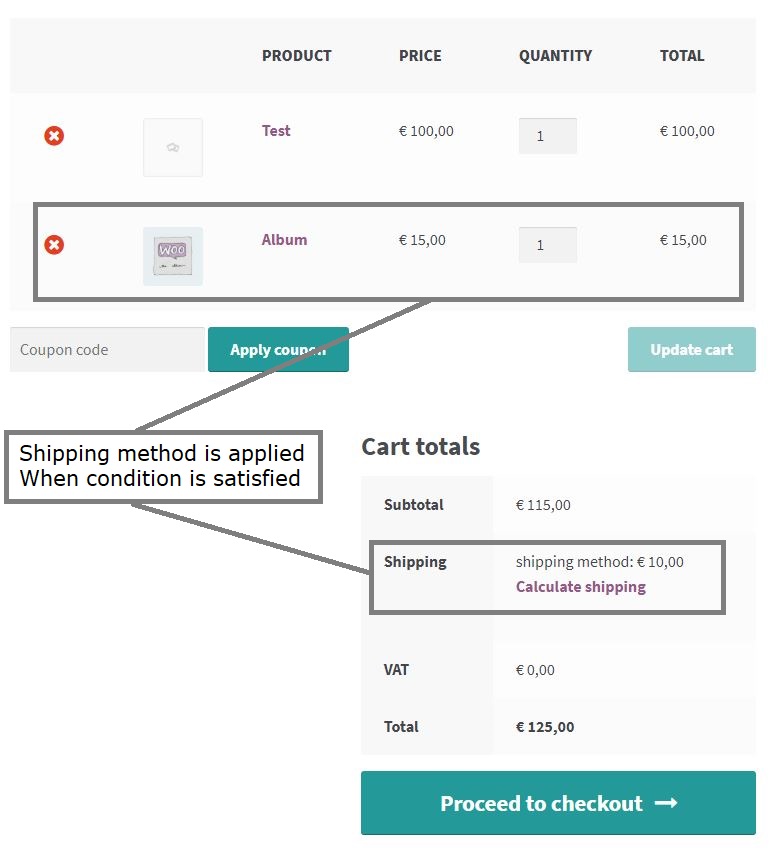
Getting Started
↑ Back to topShipping Methods
↑ Back to top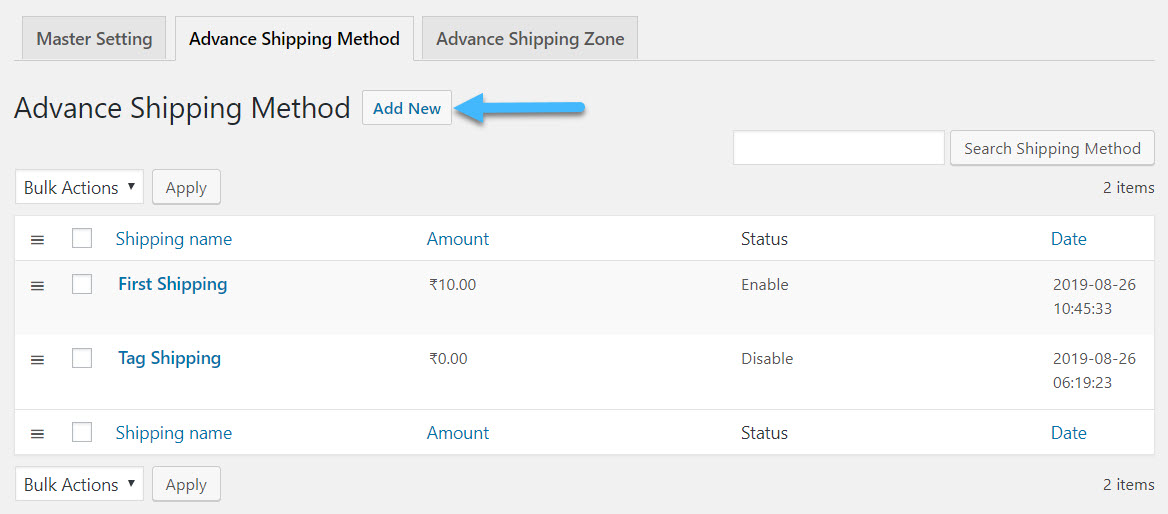
Fee Configuration Form
↑ Back to top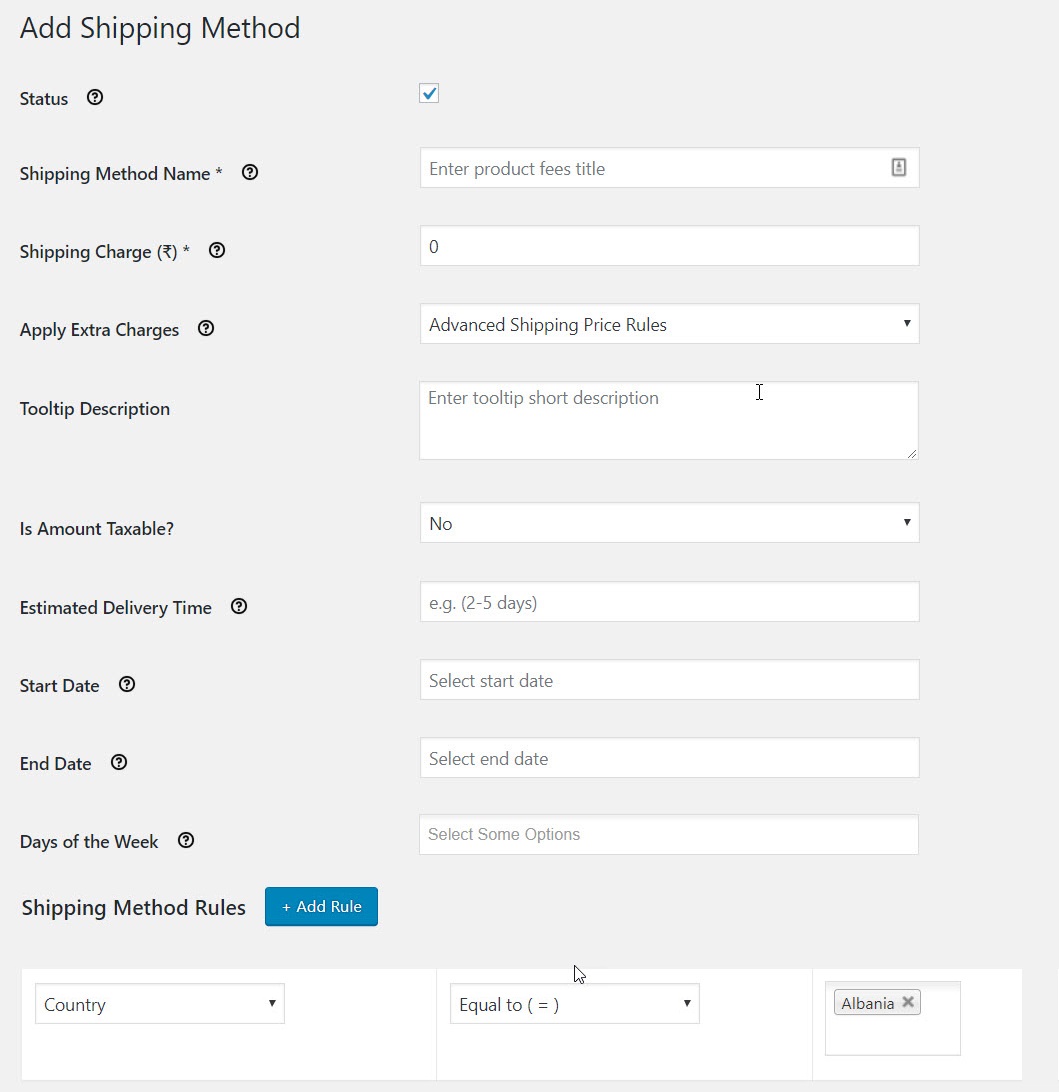
- Status of your shipping method can be enabled or disabled. You can set this toggle button to ‘enabled’, if you want your method to work and ‘disabled’, if you don’t want it to affect your WooCommerce shop.
- Shipping method name, which should be an understandable phrase as it’ll be later used for re-accessing the method. This name will also be visible for your buyers on the cart page.
- Shipping charge is the field, in which, you have to specify the flat rate cost for the method you’re creating.
- Tooltip Description is a short description of your method. It will be visible to your customers if they’ll hover on the method name in their cart.
- Is Amount Taxable?’ dropdown facilitates you to specify whether or not you want to apply taxes for the shipping amount.
- Estimated Delivery Time field is for specifying the estimated duration or day for shipping so that buyers could know about it.
- Start Date field is for adding a date, from which your method will be applicable. Because of this option, you can create your shipping methods in advance and schedule their start date. It is an optional field and can be left blank.
Shipping Rules or Conditions
↑ Back to top
 In this form, you can choose the parameter from the left dropdown list, a conditional operator from the middle dropdown list and add the values to be compared in the right side field. Also, you can add as many rules to a method as you want. For that, click on ‘Add Rule’ and repeat the process for creating a rule (as described in the previous paragraph).
Following conditional operators are allowed –
In this form, you can choose the parameter from the left dropdown list, a conditional operator from the middle dropdown list and add the values to be compared in the right side field. Also, you can add as many rules to a method as you want. For that, click on ‘Add Rule’ and repeat the process for creating a rule (as described in the previous paragraph).
Following conditional operators are allowed –
- Equal to (=)
- Not equal to (! =)
- Less than (<)
- Less than or equal to (< =)
- Greater than (>)
- Greater than or equal to (> =)
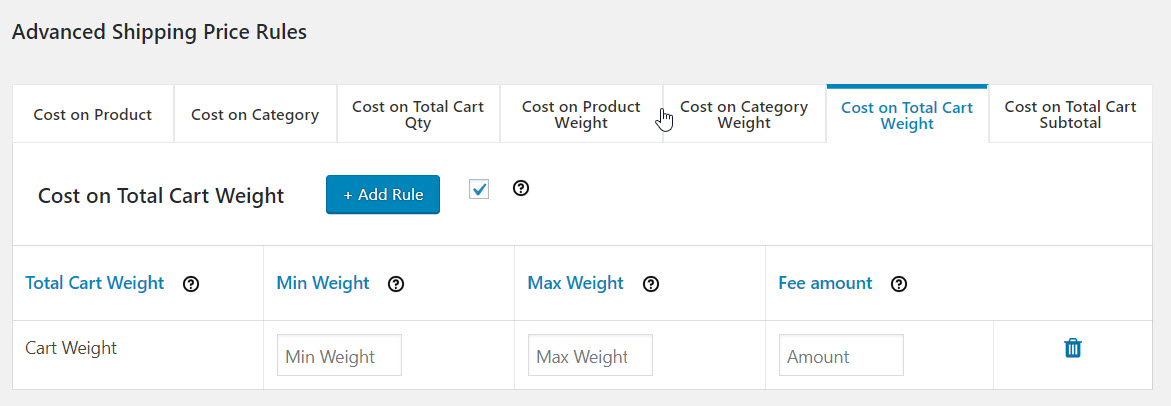
Custom Shipping Zones
↑ Back to top- For countries
- For states and countries
- For zip codes (cities or regions from different countries)
Countries Based Shipping Zone
↑ Back to top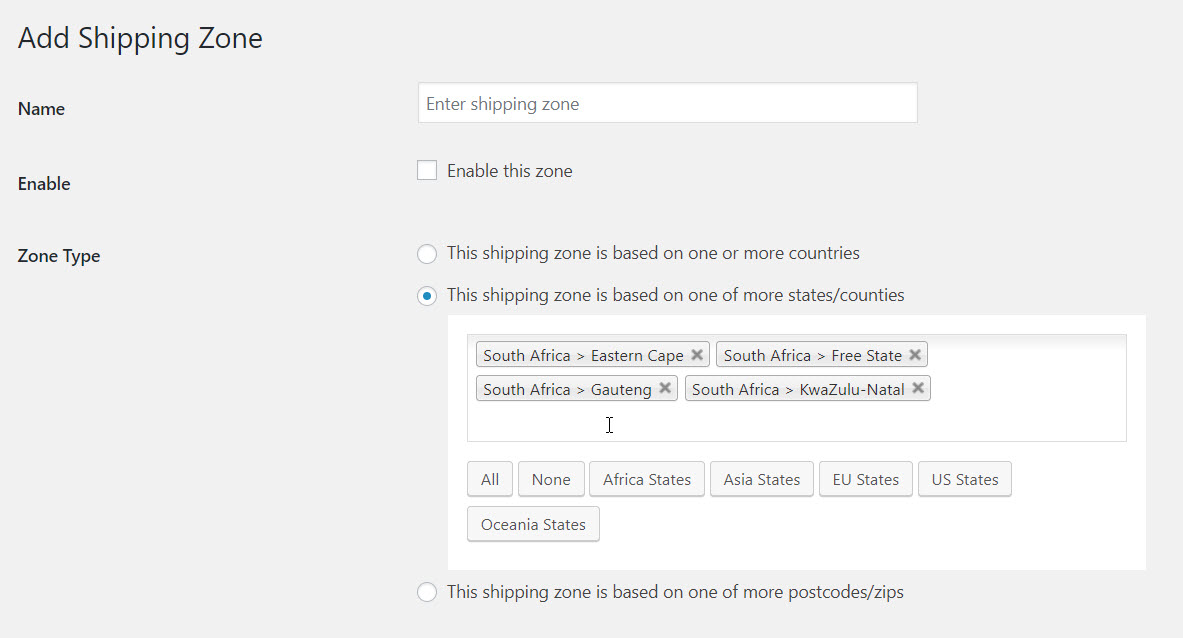
States and countries Based Shipping Zone
↑ Back to top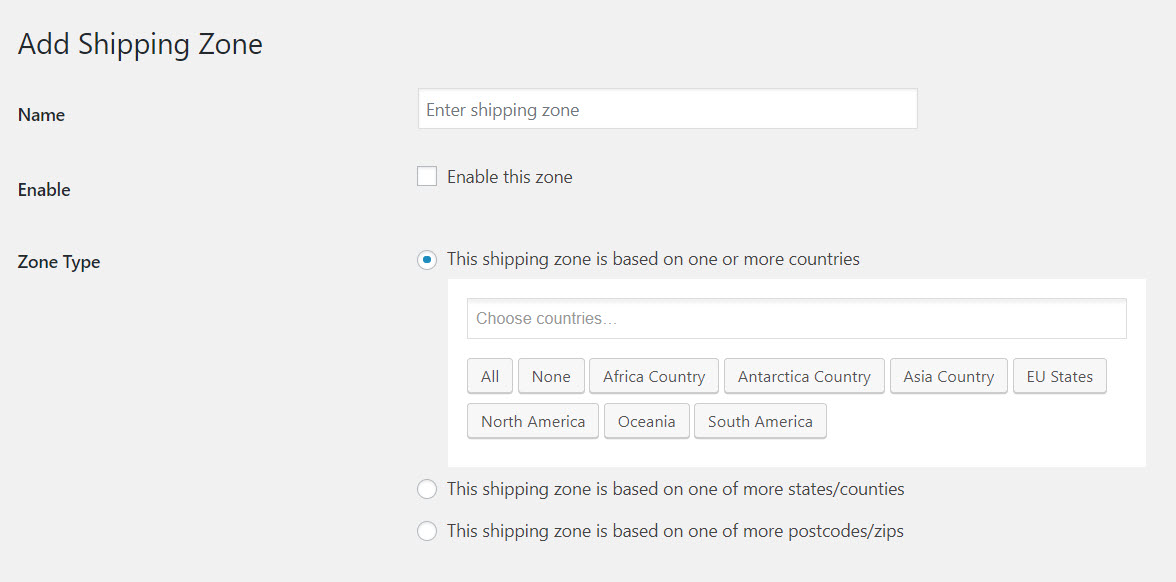
Postcodes Based Shipping Zone
↑ Back to top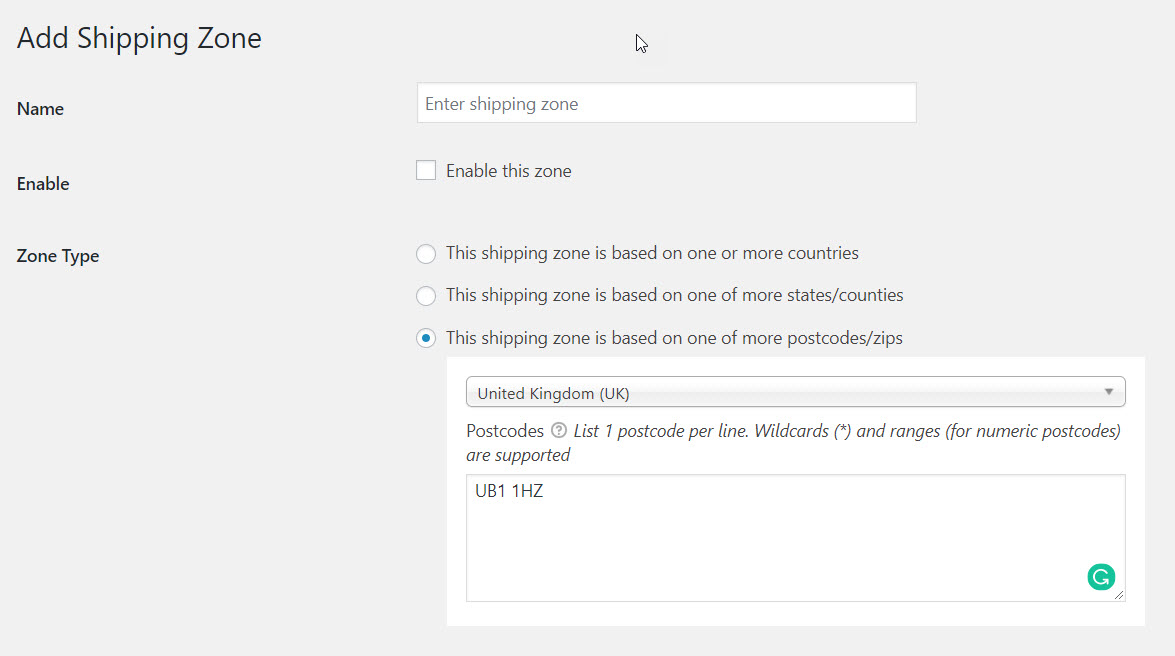 Once you’ve added these details, save your custom shipping zone and use it in the shipping methods whenever you want.
Once you’ve added these details, save your custom shipping zone and use it in the shipping methods whenever you want.
Master Settings
↑ Back to top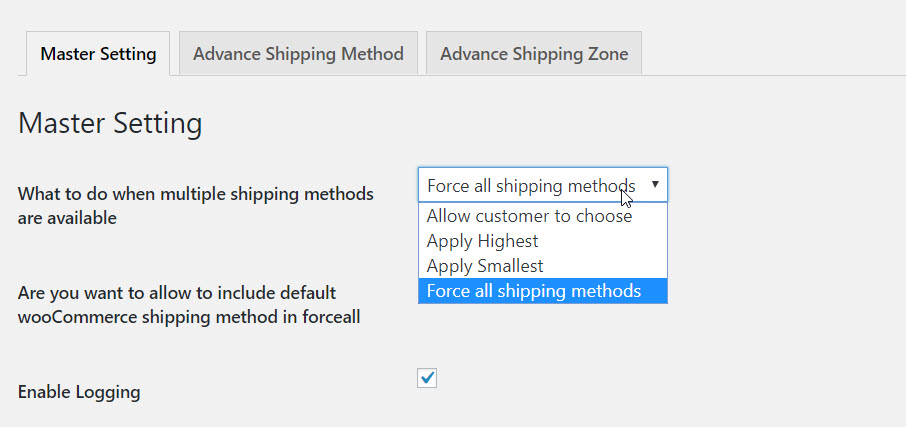 There are 4 ways you can resolve the conflict of multiple shipping methods –
There are 4 ways you can resolve the conflict of multiple shipping methods –
- Minimum shipping charges
- Maximum shipping charges
- Let your customer choose an optimal shipping method to be applied to the cart.
- Force all the shipping methods on the plugin
| Parameter | Modifier | What does it do? |
| Country | Equal to (=) | It matches if the cart contains a particular country or a set of countries. |
| Not equal to (!=) | It matches if the cart excludes a particular country or a set of countries. | |
| State | Equal to (=) | It matches if the cart contains a particular state or a set of states. |
| Not equal to (!=) | It matches if the cart excludes a particular state or a set of states. | |
| Postcode | Equal to (=) | It matches if the cart contains a particular postcode or a set of postcodes. |
| Not equal to (!=) | It matches if the cart excludes a particular postcode or a set of postcodes. | |
| Zone [You can create zones using this plugin itself] | Equal to (=) | It matches if the cart contains a particular zone or a set of zones. |
| Not equal to (!=) | It matches if the cart excludes a particular zone or a set of zones. | |
| Product Name | Equal to (=) | It matches if the cart contains a particular product or a set of products. |
| Not equal to (!=) | It matches if the cart does not contain a particular product or a set of products. | |
| Variable Product | Equal to (=) | It matches if the cart contains a particular variation of a product or a set of variable products. |
| Not equal to (!=) | It matches if the cart does not contain a particular variation of a product or a set of variable products. | |
| Category | Equal to (=) | It matches if the cart contains products belonging to a particular category or more categories. |
| Not equal to (!=) | It matches if the cart does not contain products belonging to a particular category or more categories. | |
| Tag | Equal to (=) | It matches if the cart contains a particular tag or a set of tags on its items. |
| Not equal to (!=) | It matches if the cart does not contain a particular tag or a set of tags on its items. | |
| SKU | Equal to (=) | It matches if the cart contains a particular Product SKU or a set of product SKUs. |
| Not equal to (!=) | It matches if the cart does not contain a particular Product SKU or a set of product SKUs. | |
| User | Equal to (=) | It matches if the cart contains a particular username or a set of usernames. |
| Not equal to (!=) | It matches if the cart does not contain a particular username or a set of usernames. | |
| User Role | Equal to (=) | It matches if the cart contains users with a particular user role. You can add one or more user roles for this query. |
| Not equal to (!=) | It matches if the cart excludes users with a particular user role. You can add one or more user roles for this query. | |
| Cart subtotal (You can determine whether you want to apply this condition to the cart subtotal before Discount or the cart subtotal after Discount) | Equal to (=) | It checks if the cart subtotal is equal to a particular amount. |
| Not equal to (!=) | It checks if the cart subtotal is NOT equal to a particular amount. | |
| Less than or equal to (<=) | It checks if the cart subtotal is less than or equal to a particular amount. | |
| Less than (<) | It checks if the cart subtotal is less than a particular amount. | |
| Greater than or equal to (>=) | It checks if the cart subtotal is greater than or equal to a particular amount. | |
| Greater than (>) | It checks if the cart subtotal is greater than a particular amount. | |
| Quantity | Equal to (=) | It checks if the quantity of items in user’s cart is equal to a particular amount. |
| Not equal to (!=) | It checks if the quantity of items in user’s cart is NOT equal to a particular amount. | |
| Less than or equal to (<=) | It checks if the quantity of items in user’s cart is less than or equal to a particular amount. | |
| Less than (<) | It checks if the quantity of items in user’s cart is less than a particular amount. | |
| Greater than or equal to (>=) | It checks if the quantity of items in user’s cart is greater than or equal to a particular amount. | |
| Greater than (>) | It checks if the quantity of items in user’s cart is greater than a particular amount. | |
| Weight | Equal to (=) | It checks if the weight of cart or product (in case of additional conditions) is equal to a particular amount. |
| Not equal to (!=) | It checks if the weight of cart or product (in case of additional conditions) is NOT equal to a particular amount. | |
| Less than or equal to (<=) | It checks if the weight of cart or product (in case of additional conditions) is less than or equal to a particular amount. | |
| Less than (<) | It checks if the weight of cart or product (in case of additional conditions) is less than a particular amount. | |
| Greater than or equal to (>=) | It checks if the weight of cart or product (in case of additional conditions) is greater than or equal to a particular amount. | |
| Greater than (>) | It checks if the weight of cart or product (in case of additional conditions) is greater than a particular amount. | |
| Shipping Class | Equal to (=) | It matches if the cart contains a shipping class out of the one or more shipping classes as added to this list. |
| Not equal to (!=) | It matches if the cart does not contain a shipping class out of the one or more shipping classes as added to this list. | |
| Coupon | Equal to (=) | It matches if the cart contains a coupon code out of the one or more coupons added to this list. |
| Not equal to (!=) | It matches if the cart does not contain a coupon code out of the one or more coupons added to this list. |
Examples
↑ Back to topExample 1 – Enable free shipping for your WooCommerce Store
In the fee configuration form, specify the shipping charge to be Zero (0). If you want to apply free shipping for your whole cart, do not add any condition in the conditional shipping rule section and save settings.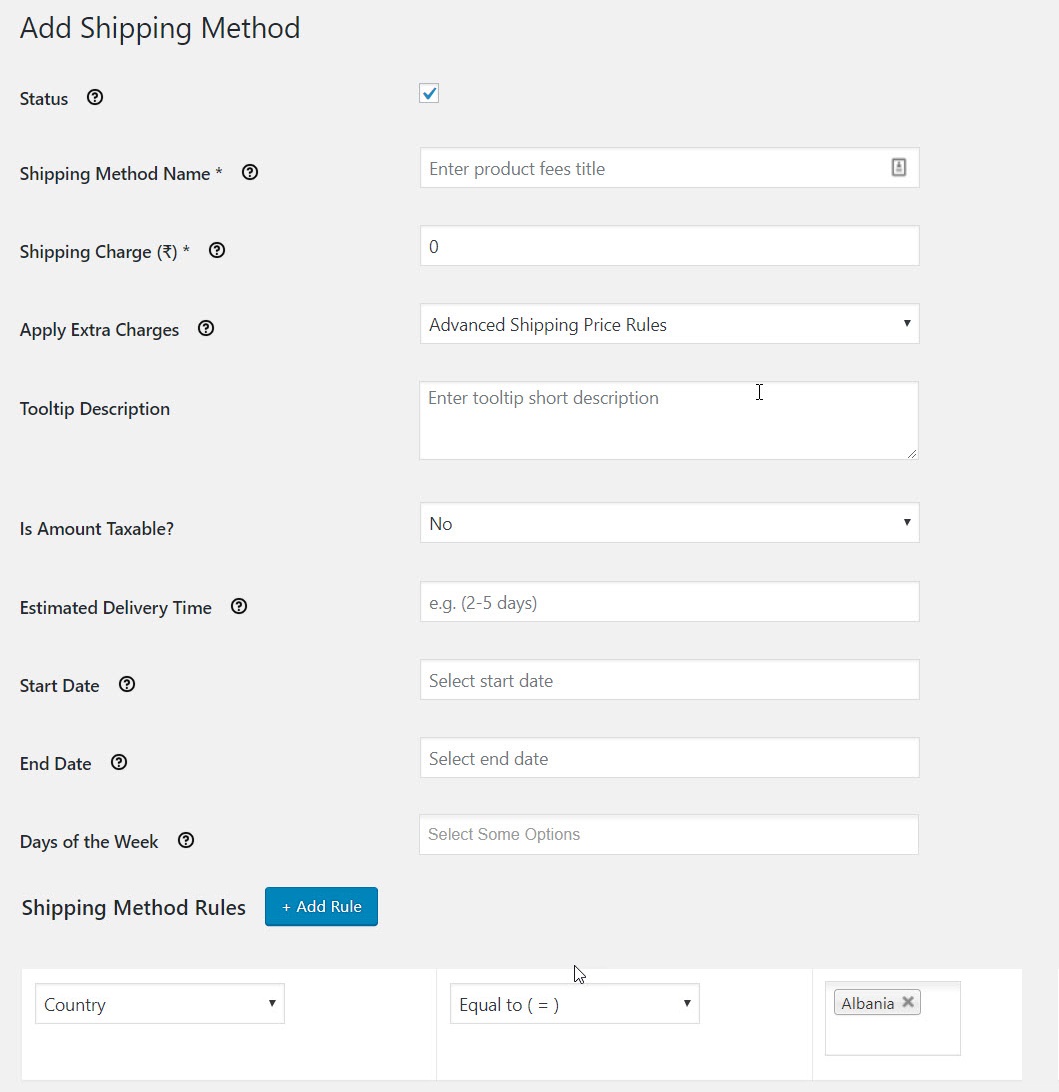 If you want to apply free shipping charges for a particular condition, add rules related to it, for example –
If you want to apply free shipping charges for a particular condition, add rules related to it, for example –
- For running a free shipping offer in a particular state (let’s say – California), add a state-specific rule and mention the name of that state.
- To offer your customers free shipping services for the Televisions category, add a category-specific rule and mention the category as ‘televisions’.
- If you want to supply Televisions to California for free, apply both the conditional rules which we’d created above. Save settings to apply your changes.
Example 2 – Creating a Flat Rate Shipping Method for Buyers belonging to Albania
For this, create a country-specific rule and fill ‘Albania’ in the value field for comparison. Add the flat rate charges in the fee configuration form and save the settings.
Example 3 – Create a Shipping Rule for a Variable Product
Consider that you want to charge $2 for shipping of black large-size variant of a Product named ‘WordPress Pennant’. To do so, you will have to select ‘cart containing variable product’ option and type the name of variant so that the desired product could be added in the right-side box. Specify the flat rate shipping cost ($2) and other details in the fee configuration form before you save the settings.
Specify the flat rate shipping cost ($2) and other details in the fee configuration form before you save the settings.
Example 4 – Set Flat Rate Shipping Rule for your Subscribers
Want to give your subscribers a discount on shipping? Do it by specifying a separate cost for shipping using Advanced Flat Rate Shipping For WooCommerce Plugin. Just add a User role specific rule and mention ‘subscriber’ as its value for comparison. Now, specify the shipping charge for them and you’re done!
Now, specify the shipping charge for them and you’re done!
Example 5 – Set Shipping Cost Based on Coupons
Are you running some sales on your e-commerce store through coupons? You can give your customers a shipping discount for applying coupons using our plugin. For this, shop owners just have to apply a coupon-specific conditional rule [in this example – code939615] and add the shipping charge for this overall method in the fee configuration form. Finally, save settings.
Example #6 – Applying Specific Flat Rate Shipping Charges when purchases 5 or More items of the same product.
In all the above examples, we’ve added 1 rule per method. However, it is not a restriction. You can add as many rules to your shipping rules to your methods as you want. For instance – If you are willing to specify a shipping charge for 5 items of a Logo Collection product, you’ll specify it in a similar way as we’ve done in the screenshot below –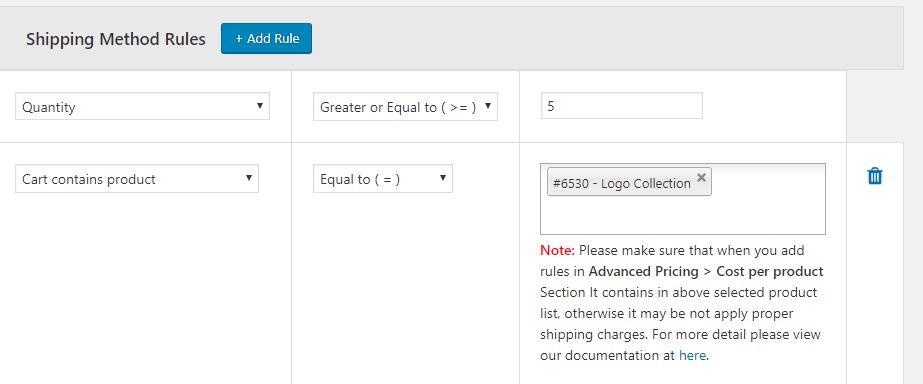 Similarly, you can create hundreds of such methods and rules as per your e-commerce store’s needs.
Similarly, you can create hundreds of such methods and rules as per your e-commerce store’s needs.
FAQs
↑ Back to top-
How can I charge two different shipping rates for two variants of one product? Is it possible through Advanced Flat Rate Shipping Plugin?